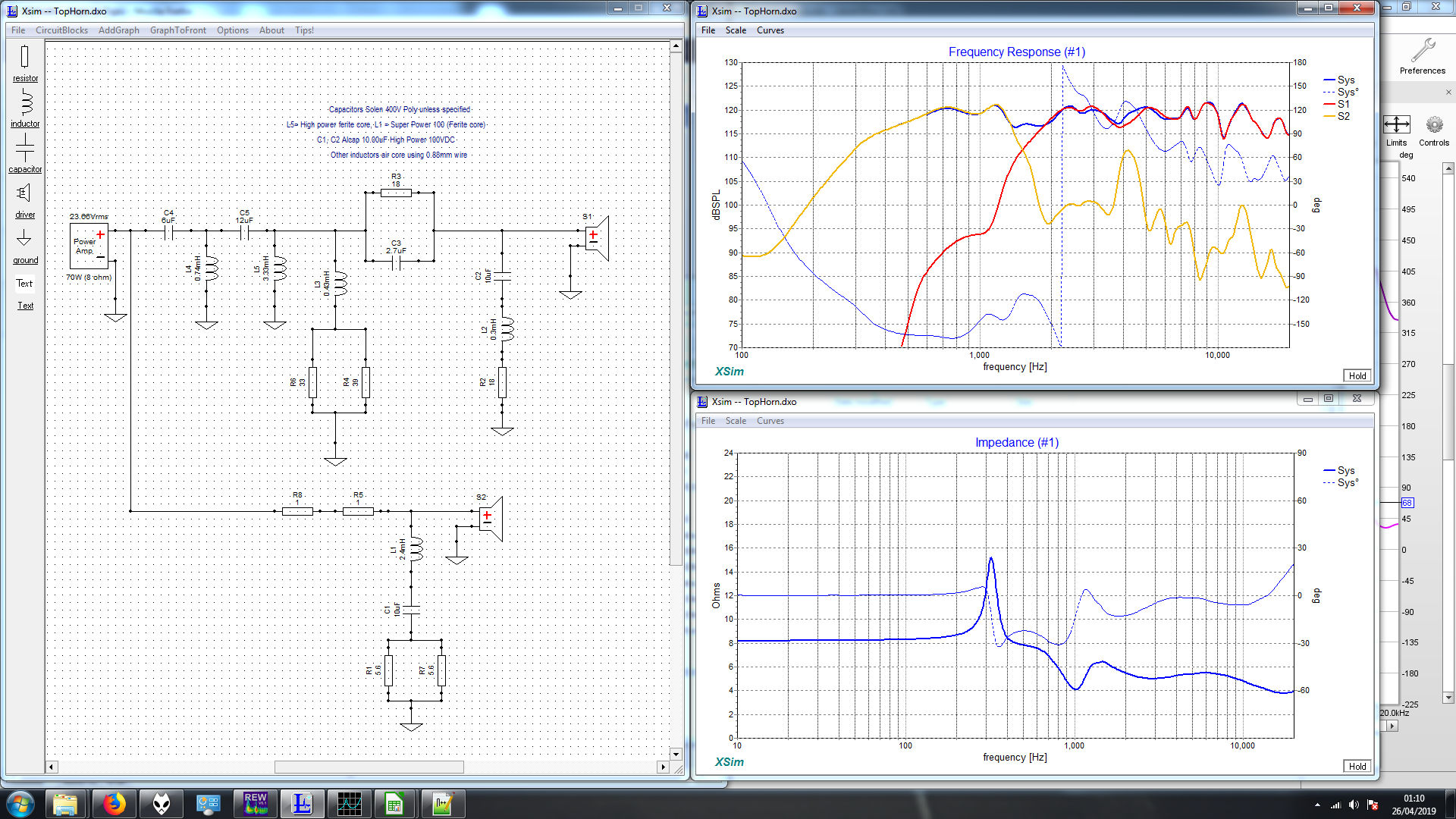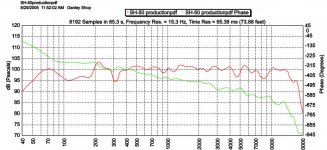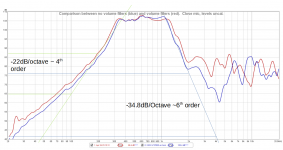For the SH-50 (blue) I curve traced the amplitude and phase response using webplot digitizer from the datasheet and the interpolated the resulting curves onto a a uniformly spaced grid of 1001 points between 40Hz and 20kHz. I then created a text file of the results (attached to previous post) and imported it into REW. The small steps you can see will be errors in this process.
For my own speaker (green) its just a time gated on axis frequency response measurement taken in REW which I have applied 1/12th octave smoothing to (as group delay is the derivative of phase its very noisy otherwise).
Looking at the plots it appears REW has drawn the scale incorrectly its actually a range of +/-2mS.
For my own speaker (green) its just a time gated on axis frequency response measurement taken in REW which I have applied 1/12th octave smoothing to (as group delay is the derivative of phase its very noisy otherwise).
Looking at the plots it appears REW has drawn the scale incorrectly its actually a range of +/-2mS.
I think what makes the passive xovers mysterious in the DSL synergies is because they are almost always discussed at the same time with how to choose and properly fit the various driver sections and ports onto the synergy horn.
Get's complicated quick !😉
Because the passive xovers on their own don't seen any different than for any other speaker.
I had the opportunity to discuss synergy driver selection, crossovers, and port placements with Mr Danley about a year and a half ago.
He told me he would have recommended LspCAD for xover development, as it does a good job simulating both mag and phase of the combined driver and xover acoustic output.
But he said since I use rephase, I can do anything. (He went on to tell me he had used rephase to overlay tuning on top of his at-home SH-50's)
I think using LspCAD, or Vituixcad, or any other program that can simulate the combined acoustic reponse of both driver and xover, mag and phase, is the nuts behind making a good passive xover.
Because using a passive design program to find the correct electrical xover for a given raw driver response, seems entirely analogous to using an active program to do the same function.
One's analog, one's digital, but both with the same design logic...embed it all into a final filter.
So really imo, the distinction between using named and un-named xovers is not even relevant when using software design for either passive or active.
As all xovers end up becoming "un-named", once they are summed with the stuff that effects any response in the xover summation region....like EQ's, all-pass, delays, etc...
The electrical transfer function with all its components becomes the xover.....and essentially un-nameable ....whether it has a named xover component in it or not...it's just semantics...
With regard to the order of the passives used by DSL.
Well, heck..with passives who doesn't know that low order works better than high, at minimizing phase rotation and group delay.
So, how low an order can a relatively powerful 3-way be kept to?
I figure you have to assume drivers with first order rolloffs as the best real world starting possibility.
If they had sufficiently broad flat mag and phase, and you didn't need to drive them too hard, maybe even no xovers could be employed....but this just isn't real world.
Real world requires the addition of a first order electrical xover to be able to stitch them together and meet any kind of SPL design goals, imo.
I believe the goal of the synergy xover design is to try to stay close to realizing a 2nd order acoustical output, after adding the electrical xover.
That is try to use a 1st order electrical xover between the low and mids, and also one between the mids' and CD.....with mounted drivers that have no worse than close-to-1st order natural rolloffs available for tie together.
It appears the SH-50's phase curve reflects that goal.
Look at the full 400 degrees of phase rotation between the center of the low drivers range and towards the center of the CD's range.
Two 2nd+ order xovers in that range...note phase scale.
Also note the additional phase tails on the high and low far ends.
There's a lot of total phase rotation imho.
But for a relatively high power 3-way for probable use with a sub, it's a heck of second-order passive xover design, huh ?🙂
I think DSL uses passives primarily because it makes products that fit their marker segment (install, particularly large scale install).
Otherwise, i believe we would be seeing active DSL products.
As ime/imo, active especially with linear phase xovers via FIR, has plenty more SQ potential.
But that's another song and dance 😀
Get's complicated quick !😉
Because the passive xovers on their own don't seen any different than for any other speaker.
I had the opportunity to discuss synergy driver selection, crossovers, and port placements with Mr Danley about a year and a half ago.
He told me he would have recommended LspCAD for xover development, as it does a good job simulating both mag and phase of the combined driver and xover acoustic output.
But he said since I use rephase, I can do anything. (He went on to tell me he had used rephase to overlay tuning on top of his at-home SH-50's)
I think using LspCAD, or Vituixcad, or any other program that can simulate the combined acoustic reponse of both driver and xover, mag and phase, is the nuts behind making a good passive xover.
Because using a passive design program to find the correct electrical xover for a given raw driver response, seems entirely analogous to using an active program to do the same function.
One's analog, one's digital, but both with the same design logic...embed it all into a final filter.
So really imo, the distinction between using named and un-named xovers is not even relevant when using software design for either passive or active.
As all xovers end up becoming "un-named", once they are summed with the stuff that effects any response in the xover summation region....like EQ's, all-pass, delays, etc...
The electrical transfer function with all its components becomes the xover.....and essentially un-nameable ....whether it has a named xover component in it or not...it's just semantics...
With regard to the order of the passives used by DSL.
Well, heck..with passives who doesn't know that low order works better than high, at minimizing phase rotation and group delay.
So, how low an order can a relatively powerful 3-way be kept to?
I figure you have to assume drivers with first order rolloffs as the best real world starting possibility.
If they had sufficiently broad flat mag and phase, and you didn't need to drive them too hard, maybe even no xovers could be employed....but this just isn't real world.
Real world requires the addition of a first order electrical xover to be able to stitch them together and meet any kind of SPL design goals, imo.
I believe the goal of the synergy xover design is to try to stay close to realizing a 2nd order acoustical output, after adding the electrical xover.
That is try to use a 1st order electrical xover between the low and mids, and also one between the mids' and CD.....with mounted drivers that have no worse than close-to-1st order natural rolloffs available for tie together.
It appears the SH-50's phase curve reflects that goal.
Look at the full 400 degrees of phase rotation between the center of the low drivers range and towards the center of the CD's range.
Two 2nd+ order xovers in that range...note phase scale.
Also note the additional phase tails on the high and low far ends.
There's a lot of total phase rotation imho.
But for a relatively high power 3-way for probable use with a sub, it's a heck of second-order passive xover design, huh ?🙂
I think DSL uses passives primarily because it makes products that fit their marker segment (install, particularly large scale install).
Otherwise, i believe we would be seeing active DSL products.
As ime/imo, active especially with linear phase xovers via FIR, has plenty more SQ potential.
But that's another song and dance 😀
Attachments
Here are some close mic'ed measurements of my unity mids (at horn mouth), as you can see the intrinsic high frequency roll off is quite steep and higher than 4th order bandpass due to the offset horn cancellation notch. I didn't need any electrical low pass on it, all acoustic.
Attachments
Hi kipman, Merry Christmas to you and all !
That's a nice flat plateau for your mid section !
(Btw, +1 to your post #13....i guess i was kinda just saying the same thing again)
Was that raw, or with some filters?
If fully raw and without any kind of high-pass, what did you end up doing for hp?
Did you add any para or shelving EQ's on the low-pass side, to bring response above 2k down any?
I'm ok with skipping a low-pass, when natural rolloff is sufficient.
But I do try to keep an acoustic rolloff target order to hold down to -30dB.
So i'd probably add some paras / or shelving to knock that down some,.....
that is, if i was in manual IIR tuning mode....but that's just my approach, being a fan of out-of-band EQs..
That's a nice flat plateau for your mid section !
(Btw, +1 to your post #13....i guess i was kinda just saying the same thing again)
Was that raw, or with some filters?
If fully raw and without any kind of high-pass, what did you end up doing for hp?
Did you add any para or shelving EQ's on the low-pass side, to bring response above 2k down any?
I'm ok with skipping a low-pass, when natural rolloff is sufficient.
But I do try to keep an acoustic rolloff target order to hold down to -30dB.
So i'd probably add some paras / or shelving to knock that down some,.....
that is, if i was in manual IIR tuning mode....but that's just my approach, being a fan of out-of-band EQs..
Merry Christmas,
The mid responses are raw responses but the response is measured at the horn mouth so directivity effects are not accurate.
I think this is close to the final filters (S1 tweeter, S2 mid) :

I would probably skip the passive filter apart from sensitivity padding and a protection capacitor now I'm more confident with fully active systems though.
The mid responses are raw responses but the response is measured at the horn mouth so directivity effects are not accurate.
I think this is close to the final filters (S1 tweeter, S2 mid) :
I would probably skip the passive filter apart from sensitivity padding and a protection capacitor now I'm more confident with fully active systems though.

